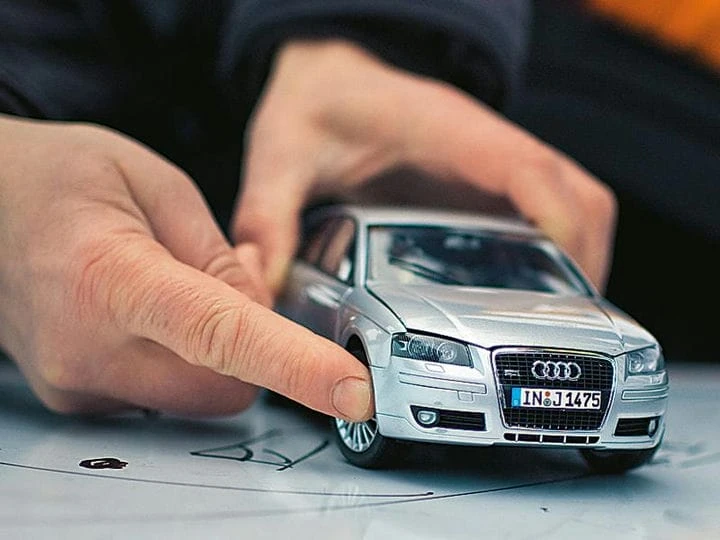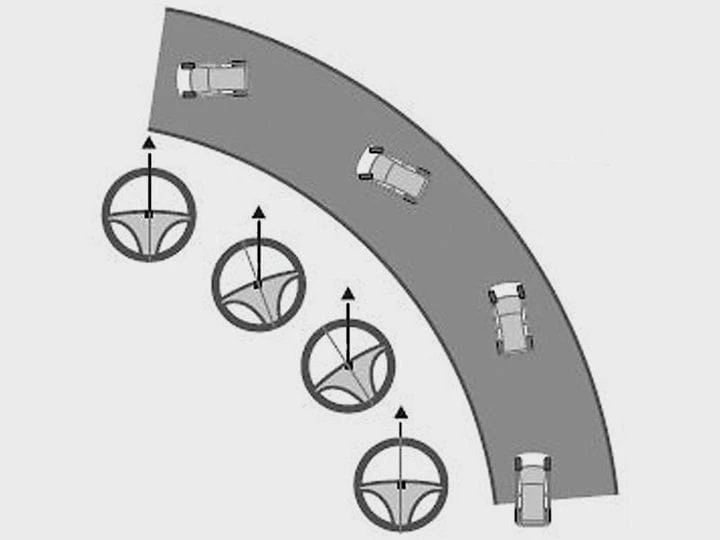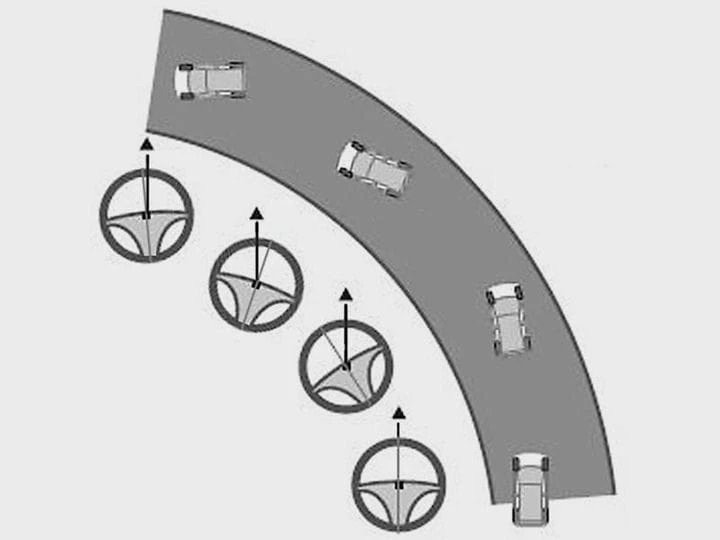Against slippage. Features of driving on snow and ice
In particular, the behavior of cars with various types of drives on ice, and other nuances of safe driving in winter conditions, the readers of the “Horn” were made by the rally driver, the chief instructor of the Quatro driver school, Evgeny Vasin.
The head coach of the Quatro school Evgeny Vasin:
“Don't be afraid to slow down”
Meet by clothes..
Many accidents happen because the driver is not properly… dressed. For example, in a coat or sheepskin coat to drive. You are not constrained and, if necessary, will not be able to quickly operate the wheel. The same can be said about the huge jacket. They are hard to climb in the car, not to mention competent management.
Clothing should be chosen in such a way that it does not interfere with driving. A jacket is better for this, preferably with a belt. If you prefer a down jacket, you must remember the basic safety rules. Once buttoned, unzip the jacket and slide the belt underneath. The fact that the jacket serves as an additional buffer between the body and the harness. As a result, the belt does not fit tightly to the body, and in the event of an accident, you risk injuring the chest.
Remember that if you are cold, it will not lead to anything good either. When the muscles pull you tight.
The heat contrast is as bad as it relaxes, the reaction is blunted. The temperature in the car should be lower than at home. That is, it was warm, but there was no desire to undress to a T-shirt.
You also need to choose shoes. Boots can be warm, but preferably with thin soles. Because the thick sole allows you to feel the pedals. I'm not talking about a soft pedal, even brake pads with a “load protector” are not felt. And your safety depends on the possibility of dosage for slowing down and speeding up.
No need to operate the machine with normal gloves. If they are made of wool, your hands will simply slide on the steering wheel. Leather gloves with fur are not the best option, as in this case the sensitivity worsens. Another thing – special gloves for driving. They hands are not cold, and the contact with the steering wheel is perfect.
start-stop
Acceleration from standstill in winter is largely dependent on the type of drive, tires and, of course, the road. It is clear that a four-wheel drive car will shoot more confidently than a front- or rear-wheel drive car, and the car starts better than usual on studded tires on ice. However, the main fault for all types of vehicles is the start.
Even in motorsport for four-wheel-drive cars, pilots don't press on the gas to begin with. This only leads to slippage. And in case the car is a stabilization system, retarded acceleration, as this system “suffocates” the engine. First, you need to smoothly move the car from a place, and then gain momentum. Sliding is still unavoidable, but the car is already in motion and can reach the desired speed.
The braking distance depends on the tires. If you spend more than 60% of your time in the city, then you don't need studded tires. Worse, they hold the road on wet pavement, and therefore the braking distance will be longer. Studs give you an advantage on icy roads.
Brake lighter. Most modern cars are equipped with ABS systems, so the drive is not important. Also, in emergency situations, I recommend braking to the floor with as much force as you want to break the pedal, as ABS allows you to continue driving the vehicle without the wheels locking up.
The brake motor must be removed and braked in neutral. The fact that the engine, especially at low speeds, creates an additional obstacle for the anti-lock system and the braking distance increases. And in order to reduce gear in sports, not everyone knows. And again, this is not necessary.
If there is no ABS, of course, without engine braking (downshifting) is clearly not enough, as this is a faster way to brake and not block the wheels. But you need to consider the type of disk. Sharply lowered in the rear – the car can go into a skid in the front – into demolition. Therefore, you need to smoothly switch. In addition, the driver can simulate the ABS system. Periodically attack the brake pedal to effectively brake, and the wheels, again, do not lock up, making it possible to steer the car where you want it.
Arguments drive
Rear wheel drive vehicles are more prone to drifting. To avoid this when cornering, you need to be very careful with the gas pedal. It should be smooth. A little overdone – the rear axle begins to slip. The same effect will be if you sharply throttle on the rear wheels of the car.
If the car has a stabilization system that bends more safely. But remember: if the ESP interferes with the control process, so you have done something wrong.
If it was not possible to avoid skidding, it is necessary to use countersteering – this is to turn the wheel in the direction of skidding. But not for long, immediately return the steering wheel to its original position. The fact is that if you have a delay with countersteering, that is, there is the possibility of re-skidding, the car will shake, and it will be much more difficult to deal with it.
Cars with front-wheel drive, by contrast, are more likely to skid the front axle. This happens for two reasons: in turn, you have too much gas, the drive wheels will start to rotate, the car slides and it makes a trajectory. The second reason is to go into a turn too much you turned the wheel, the wheels lost traction and went to drift.
The main understeer error is to add gas in the hope that the front-wheel drive will eventually pull the car. On the contrary, it will increase the drift and departure from the road.
If you turn on your front-wheel drive car began to slip, it should be throttled, but not completely, by slightly reducing the pressure on the pedal. The wheel needs to be straightened a little, so the car is caught on the surface. If this is not enough, you can still throttle. In this case, the momentum of the rear of the car will begin to turn, and you will be able to enter the turn. However, the car may skid a little. But by using countersteering and adding throttle, you can quickly stabilize the car.
All-wheel drive cars are the most reliable in terms of handling, but also the most insidious. People are stepping over rear or front-wheel drive 4×4 vehicles, significantly increasing the speed of movement in winter, including when cornering. Why? Yes, because all-wheel drive allows one and a half times faster in corners. And the higher the speed, the more difficult it is to cope with the machine.
Modern vehicles are all four-wheel drive vehicles that behave primarily as rear-wheel drive. Since the ratio of thrust they were divided, as a rule, 40:60.
To avoid any emergencies, one by one will have to smooth out the throttle. This is the key to success.
If you went too far with the speed at the entrance to the turn and the car began to skid, release the gas a little, and, if necessary, return the steering wheel to its original position a little, then add gas again – tighten the car due to the rear drive and the front thrust does not go into a skid.
In the event of a rear axle skid (often 4WD vehicles) it takes very little to ease the pressure on the gas pedal and countersteering – turning the steering wheel in the direction of the skid. In addition, unlike purely rear-wheel drive cars, “4×4” allows for minor errors.
Large SUVs have permanent all-wheel drive. They behave exactly like cars, but remember that they have a higher center of gravity. As a result, SUVs are more prone to rollovers and protracted hills.
Slightly different things are all-wheel drive crossovers, especially not new models. Most are front wheel drive vehicles with a rear wheel drive plug in when the front wheels slip. But it often connects at the most inopportune moment. That is, you drive a car with large front wheels, and suddenly the rear axle begins to pull. The main thing here is not to panic and not try to do something. Yes, the car will go into a small skid, but stabiliziruemost, because you pull the front wheels.
But it is better not to bring the car to drift and drift. And it does not matter that the car has stabilization or not. If it started working, it means that you have already done something wrong. Feel free to brake – this is the best way to quickly, but calmly go through any turn.



